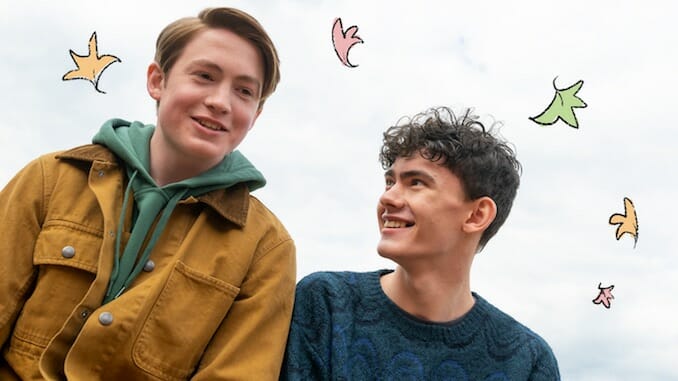Netflix’s Heartstopper Is Top-Tier Queer Adorableness
Photo Courtesy of Netflix
In the LGBTQ+ teen coming-of-age canon, a scene in which a closeted character googles “am i gay?” in the midst of a sexuality crisis has become a staple. This familiar moment of self-questioning is present in Heartstopper, but not in the way we are used to. It’s not the protagonist hesitantly spelling out G-A-Y, but the love interest. This subtle but meaningful change in Netflix’s 8-part show, derived from creator and writer Alice Oseman’s Tumblr-originated webcomics turned graphic novels, is indicative of the fresh breath of air that Heartstopper’s contemporary portrayal of LGBTQ+ youth brings to the genre.
Already out and proud, Charlie (newcomer Joe Locke) instantly makes a nice change from the closeted narratives that dominate queer coming-of-age stories. We watch as the dorky teen folds himself to fit on a school bench with his buddies, Tao (Will Gao) and Issac (Tobie Donovan)—the latter often found with an Oseman book in hand—as the trio recount their morning spent ducking away from bullies and popular kids in the corridors of Truham Grammar School for Boys. This circle of friends, each coming up against their own struggles in their formative teenage years, also includes Elle (Yasmin Finney), a transgender student who has moved to the neighbouring all-girls school.
When Charlie is allocated to his new form room, he’s seated beside Nick Nelson (Kit Connor), a rugby boy in the year above who radiates golden retriever energy. Timid greetings are exchanged between the two high schoolers, but Charlie is not interested in repressing his feelings (which appear as animated doodle butterflies that float across the screen). Across eight episodes, their friendship-turned-relationship is chronicled with considerate detail and heartwarming earnestness. Aimed at teenager viewers, with PG-rated love stares and awkward flirting, Heartstopper is a deeply wholesome portrait of navigating high school that’s devoid of booze, drugs, or sex. While this lack of edginess may dissuade some, the sweet romance that blossoms between Charlie and Nick, alongside the trials and tribulations of their friends, proves plenty engaging and never insubstantial.
While the show is largely a diverse, uplifting portrayal of LGBTQ+ youth, there is nevertheless antagonism that lingers in the Instagram comments on coming out posts, and animosity in snide jokes laced with homophobia laughed at by the popular lads. Impressively, however, the presence of these tie-wearing middle-class posh boys is secondary to the core characters who have been given dimensions that are wonderfully naturalistic. Also, the show departs from the cliche of adjacent high school stories (such as Hulu’s Love, Victor) in how Heartstopper regards sexuality with the maturity these stories have always deserved. The British context is also a nice change from the American high school setting teen TV is otherwise flooded with.
The soundtrack is comprised of nearly all women artists, including the likes of Wolf Alice, girl in red, Orla Gartland, and Maggie Rogers. Baby Queen’s catchy track “Colours of You,” written for the show, captures the electricity of teen spirit. This is paired with the rhythms of the internet generation, where silence is broken by the clacking of keyboards and the chimes of Instagram DMs coming and going. Phone screens glow in the darkness of night as messages are typed out only to be deleted when replies are second-guessed. This emotional grounding of understanding underlies Heartstopper, and ensures an in-touch, empathetic depiction that feels utterly genuine.
-

-

-

-

-

-

-

-

-

-

-

-

-

-

-

-

-

-

-

-

-

-

-

-

-

-

-

-

-

-

-

-

-

-

-

-

-

-

-

-








































